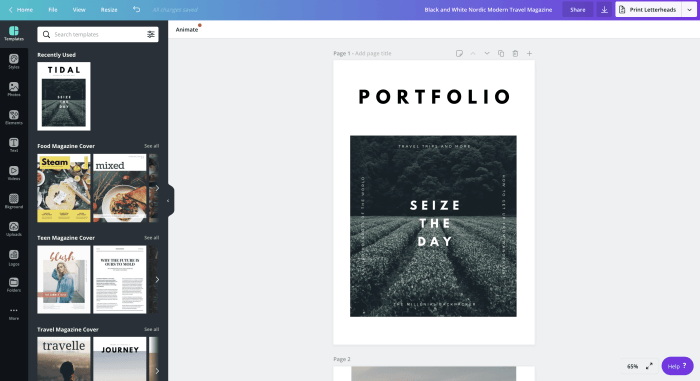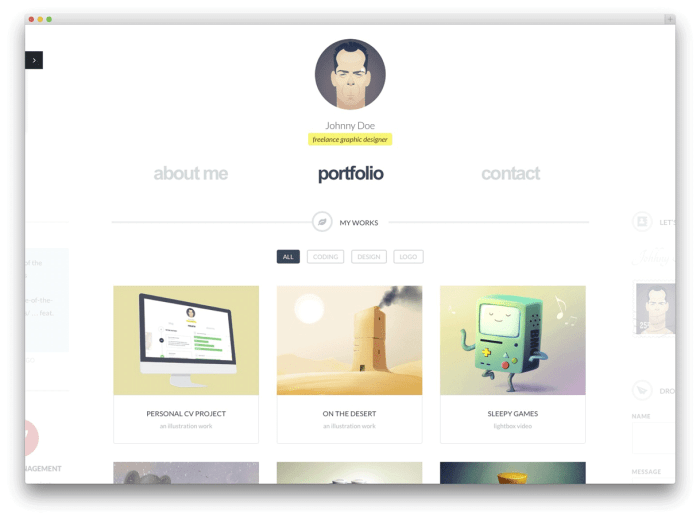Building an Online Portfolio kicks off the journey of presenting your talents in a digital realm, where creativity meets professionalism. Dive into the world of showcasing your skills in style, making a statement that resonates with your audience.
From selecting the right platform to crafting an engaging bio, this guide will take you through the essential steps of creating a compelling online portfolio that stands out from the crowd.
Introduction to Building an Online Portfolio
An online portfolio is a digital collection of work samples, projects, and accomplishments that professionals use to showcase their skills and experience to potential employers or clients. In today’s digital age, having an online portfolio is crucial for anyone looking to stand out in their field and make a lasting impression.
Benefits of an Online Portfolio
Building an online portfolio can benefit professionals in various fields in several ways. Firstly, it provides a centralized platform to display their best work, allowing them to highlight their expertise and capabilities. Secondly, an online portfolio can help professionals establish credibility and showcase their unique talents to a global audience. Lastly, having an online portfolio makes it easier for employers or clients to assess a professional’s qualifications and decide whether they are the right fit for a job or project.
Showcasing Skills and Experience
An online portfolio plays a crucial role in showcasing a professional’s skills and experience. By including work samples, testimonials, certifications, and other relevant information, professionals can effectively demonstrate their expertise in a visually appealing and organized manner. This allows them to differentiate themselves from competitors and make a strong case for why they are the best choice for a particular opportunity.
Choosing the Right Platform
When it comes to building an online portfolio, choosing the right platform is crucial for showcasing your work effectively. Different platforms offer various features and customization options, so it’s essential to select one that aligns with the type of work you want to showcase and your personal style.
Comparing Platforms
- WordPress: Known for its flexibility and wide range of themes and plugins, making it a popular choice for creatives looking for customization options.
- Squarespace: Offers sleek, modern templates with a user-friendly interface, perfect for those who prioritize aesthetics and ease of use.
- Wix: Known for its drag-and-drop functionality and beginner-friendly interface, ideal for those who want to quickly set up a professional-looking portfolio.
Tips for Platform Selection
- Consider the type of work you want to showcase: If you’re a photographer, you might prioritize platforms with stunning image galleries. If you’re a writer, you might look for platforms with emphasis on text formatting.
- Look for a user-friendly interface: Make sure the platform you choose is easy to navigate and update, allowing you to focus on adding new work rather than struggling with the technical aspects.
- Customization options are key: Choose a platform that allows you to personalize your portfolio to reflect your unique style and brand. This will help your work stand out and leave a lasting impression on visitors.
Creating a Compelling Portfolio

When it comes to building an online portfolio, there are key elements that you need to include to make it engaging and effective. Organizing your content in a strategic way is crucial to keep visitors interested and showcase your work effectively. Visual appeal and consistency in design play a significant role in making your portfolio stand out.
Essential Elements in an Online Portfolio
Before diving into organizing your content, it’s important to know what essential elements to include in your online portfolio:
- A brief introduction about yourself and your background
- Samples of your work, including projects, designs, writing samples, etc.
- Contact information for potential clients or employers to reach out to you
- Testimonials or references from previous clients or employers
Tips for Organizing Content Effectively
Here are some tips to help you organize your content in a compelling way to engage visitors:
- Categorize your work into different sections to make it easy for visitors to navigate
- Showcase your best work prominently and include a variety of projects to demonstrate your skills
- Create a clear and concise description for each project to provide context for visitors
Significance of Visual Appeal and Consistency
Visual appeal and consistency in design are crucial aspects of creating a compelling portfolio:
- Choose a cohesive color scheme and layout to create a professional look
- Use high-quality images and visuals to showcase your work effectively
- Maintain consistency in font styles, sizes, and overall design throughout your portfolio
Showcasing Work Samples
When it comes to showcasing work samples on your online portfolio, it’s essential to select and present them effectively to impress potential clients or employers. Your portfolio should highlight your skills and expertise in a way that is engaging and easy to navigate.
Creating a Diverse Portfolio
To create a diverse portfolio, include a variety of work samples that showcase different skills and projects. This could include examples of graphic design, writing, web development, photography, or any other relevant work. By showcasing a range of work, you demonstrate your versatility and expertise in multiple areas.
- Include samples that highlight your strengths: Choose work samples that best showcase your skills and accomplishments.
- Showcase different types of projects: Include a mix of personal projects, client work, and collaborations to demonstrate your range.
- Demonstrate growth and improvement: Include older work samples to show how you have evolved and improved over time.
Updating and Refreshing Work Samples
It’s important to regularly update and refresh your work samples to keep your portfolio current and relevant. This shows that you are active in your field and continuously producing new work.
- Remove outdated samples: Replace older work samples with newer, more relevant ones to keep your portfolio up to date.
- Add recent projects: Include your latest work to show potential clients or employers your most recent accomplishments.
- Seek feedback: Get input from peers or mentors on which work samples are most effective and how you can improve your portfolio.
Writing an Engaging Bio and About Me Section

When it comes to building an online portfolio, your bio and ‘About Me’ section play a crucial role in connecting with your audience on a personal level. Crafting a compelling bio can make a lasting impression and set you apart from the crowd.
Crafting a Compelling Bio
- Start with a captivating opening sentence that grabs attention and reflects your personality.
- Showcase your unique skills, experiences, and passions in a concise and engaging manner.
- Use a conversational tone to make your bio more relatable and approachable.
- Incorporate relevant s to optimize your bio for search engines and attract the right audience.
Importance of ‘About Me’ Section
Your ‘About Me’ section is where you can share your story, values, and aspirations with your audience. It humanizes your brand and helps establish a personal connection with visitors to your portfolio.
Effective Storytelling in Bios
Effective storytelling in bios involves weaving a narrative that resonates with your audience and leaves a lasting impression. Here are some examples of storytelling elements you can incorporate:
-
Start with a defining moment or anecdote that showcases your journey and passion.
- Highlight your accomplishments and experiences in a way that illustrates your skills and expertise.
- Share your values, beliefs, and motivations to give insight into who you are beyond just your work.
- End with a call to action or invitation for visitors to connect with you further.
Incorporating Testimonials and Recommendations: Building An Online Portfolio
Including testimonials and recommendations in an online portfolio is crucial for establishing credibility and building trust with potential clients or employers. These testimonials serve as social proof of your skills, professionalism, and the quality of your work, helping to showcase your expertise and reliability.
Collecting and Displaying Testimonials, Building an Online Portfolio
- Reach out to past clients or colleagues via email or social media and request a testimonial highlighting their positive experience working with you.
- Create a dedicated section on your online portfolio to showcase these testimonials, making them easily accessible for visitors to view.
- Include a mix of testimonials that highlight different aspects of your work, such as your communication skills, problem-solving abilities, or creativity.
- Ensure that each testimonial includes the name, position, and company of the person providing the recommendation to add credibility.
To effectively collect and display testimonials from clients or colleagues, consider the following strategies:
Enhancing Credibility and Trustworthiness
- By showcasing positive feedback from past clients or colleagues, you demonstrate your track record of delivering quality work and satisfying your clients’ needs.
- Testimonials provide validation of your skills and expertise, reassuring potential clients or employers that you are capable of meeting their expectations and delivering results.
- They help humanize your portfolio and establish a personal connection with visitors, showing that you are not only skilled but also easy to work with and highly recommended by others.
Testimonials play a significant role in enhancing the credibility and trustworthiness of your online portfolio: